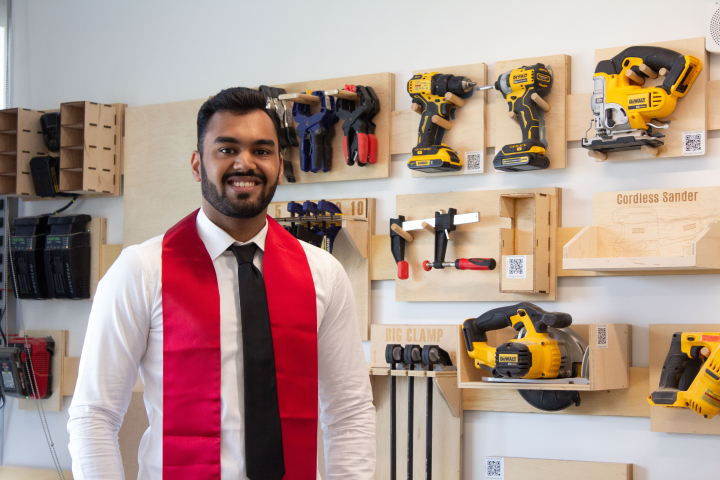Inside the Sandbox: A Conversation with Alum Hrithik Bansal
At the University of Maryland's Brendan Iribe Center for Computer Science and Engineering, the Jagdeep Singh Family Makerspace—also known as the Sandbox—is a testament to the fusion of practical skills with academic learning. Located on the first floor, the Singh Sandbox is a makerspace with six workshops and a large communal space. The 5,300-square-foot work area includes electronics testing and fabrication facilities, textile arts, woodworking, CNC machines, laser cutters, 3D printers and more. The Sandbox is primarily operated by student volunteers, fostering creativity and hands-on work.
Designed to spur innovation across all majors, the facility has significantly influenced many who have navigated its space, including computer science alum Hrithik Bansal (B.S. ’22, computer science), who previously managed the facility.
In an insightful Q&A, Bansal shares the critical hands-on experience he gained at the Sandbox and its role in shaping his career path after UMD.
Question: Can you describe your initial introduction to making and building things?
Since I was around 10, I've been fascinated with building things with my hands. It began with a simple electronics experiment I found in my brother's physics book involving a battery, some safety pins, wire and a bulb. This early exposure sparked a journey of self-exploration through hobby kits, model airplanes and Legos. My interest deepened when I joined a robotics club in middle and high school, leading to participation in competitions like Robot Wars. These experiences nurtured my passion for electronics and robotics, laying the groundwork for my future endeavors.
Question: What influenced your decision to attend the University of Maryland’s Department of Computer Science?
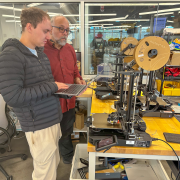 UMD’s strong robotics research program and impressive facilities were key factors in my decision to attend. Although I initially planned to focus on robotics, my interests shifted toward software. Despite this shift, the desire to build and create remained strong. Learning about the Sandbox during my freshman year was a pivotal moment. The opportunity to access a space equipped with laser cutters, a fully equipped wood shop, 3D printers, advanced electronics and more, coupled with the welcoming community, was transformative. With Gordon Crago's arrival in 2019 as the space's manager, the organization within the Sandbox began to take shape. News broke out about the need for student managers to help streamline the space's operations. Working at the Sandbox granted me 24/7 access and led to a paid position where I could leverage my building skills to contribute significantly to the space's development.
UMD’s strong robotics research program and impressive facilities were key factors in my decision to attend. Although I initially planned to focus on robotics, my interests shifted toward software. Despite this shift, the desire to build and create remained strong. Learning about the Sandbox during my freshman year was a pivotal moment. The opportunity to access a space equipped with laser cutters, a fully equipped wood shop, 3D printers, advanced electronics and more, coupled with the welcoming community, was transformative. With Gordon Crago's arrival in 2019 as the space's manager, the organization within the Sandbox began to take shape. News broke out about the need for student managers to help streamline the space's operations. Working at the Sandbox granted me 24/7 access and led to a paid position where I could leverage my building skills to contribute significantly to the space's development.
Question: In what ways did the Sandbox foster a sense of community and collaboration among its users?
The Sandbox was more than just a makerspace; it was a community hub where students from various disciplines converged to share ideas, collaborate on projects and learn from one another. By hosting workshops and events, we encouraged users to teach and learn skills in a peer-to-peer setting, fostering a culture of collaboration and mutual growth. This environment of shared knowledge and resources was instrumental in creating a vibrant community where innovation flourished, and students felt empowered to explore their creative and technical interests. 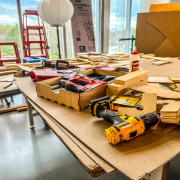
Question: How did becoming a student manager enhance your leadership and organizational skills?
Leading the space required a multifaceted approach, blending project management, team leadership and space organization. I was tasked with overseeing the integration of new tools and technologies into our space, a role that demanded both vision and attention to detail. Organizing workshops, coordinating volunteer efforts and ensuring the seamless operation of the Sandbox taught me valuable lessons in leadership, time management and effective communication. These skills have been directly applicable in my professional endeavors, enhancing my ability to lead projects and collaborate with diverse teams.
Question: Reflecting on your Sandbox projects, which one do you consider the most impactful, and why?
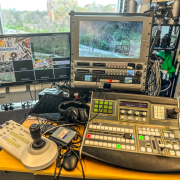 The tool checkout system I created is the most impactful among the numerous projects I undertook. By creating a web-based application that streamlined the process of borrowing tools, I addressed a tangible need, facilitating more access to essential resources. This project not only enhanced the operational efficiency of the Sandbox but also served as a personal milestone in applying my software development skills to solve real-world problems. It epitomized the Sandbox's ethos of practical learning and innovation, making a lasting difference in how students interacted with the space.
The tool checkout system I created is the most impactful among the numerous projects I undertook. By creating a web-based application that streamlined the process of borrowing tools, I addressed a tangible need, facilitating more access to essential resources. This project not only enhanced the operational efficiency of the Sandbox but also served as a personal milestone in applying my software development skills to solve real-world problems. It epitomized the Sandbox's ethos of practical learning and innovation, making a lasting difference in how students interacted with the space.
Question: How did your experiences influence your professional path and skillset?
The Sandbox was a hands-on environment for applying theoretical knowledge and enhancing my proficiency in software and hardware. My role in managing the facility and interacting with its users helped polish my people management and customer relations skills. The tool checkout application I developed also directly leveraged my expertise in React, a web framework. This particular experience became invaluable during my internship at Peloton, where I extensively utilized React. Furthermore, the hands-on nature of the work in the Sandbox showcased my ability to transform concepts into practical solutions, an attribute employers looked for and which eventually worked in my favor.
Question: Can you elaborate on the importance of spaces like the Sandbox in the context of computer science education?
The Sandbox critically complements traditional computer science education, emphasizing the importance of tangible creation alongside digital innovation. Building something with your hands provides a unique perspective on problem-solving and creativity that theoretical learning alone cannot offer. Translating strategies from physical projects to software challenges has been enlightening and practical. The Sandbox embodies this synergy, allowing students from any major to explore their creativity and develop valuable skills that enhance their academic and professional pursuits.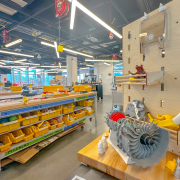
Question: What advice would you offer to computer science students at the University of Maryland who might not have visited the Sandbox yet?
Every computer science Terp should make a point to visit the Sandbox at least once. It's not just about the incredible equipment; it's about igniting your creativity. As computer science majors, we're constantly glued to our screens, but there's something special about getting hands-on with tangible projects. Sandbox offers that opportunity to exercise the creative side of your brain. And if nothing else, you'll enjoy the stunning views of Baltimore Avenue. Trust me, it's an experience you won't regret.
—Interview conducted by Samuel Malede Zewdu, CS Communications
###
Establishment of the Singh Sandbox
University of Maryland Computer Science Professor Emeritus Bill Pugh led the initiative to create the makerspace to give students essential skills to transform ideas into tangible outcomes. Pugh and his wife, Lisa Orange, donated $500,000 to support the operation of the Sandbox and an additional $250,000 to facilitate the coordination of makerspaces across the campus. UMD alum Jagdeep Singh (B.S. '86, computer science and economics) and his wife, Roshni, contributed $1 million to constructing the makerspace, now known as the Singh Sandbox. This name pays tribute to the original Sandbox, a makerspace inaugurated in 2016 within the Computer Science Instructional Center before its relocation to the Brendan Iribe Center.
The Department welcomes comments, suggestions and corrections. Send email to editor [-at-] cs [dot] umd [dot] edu.
